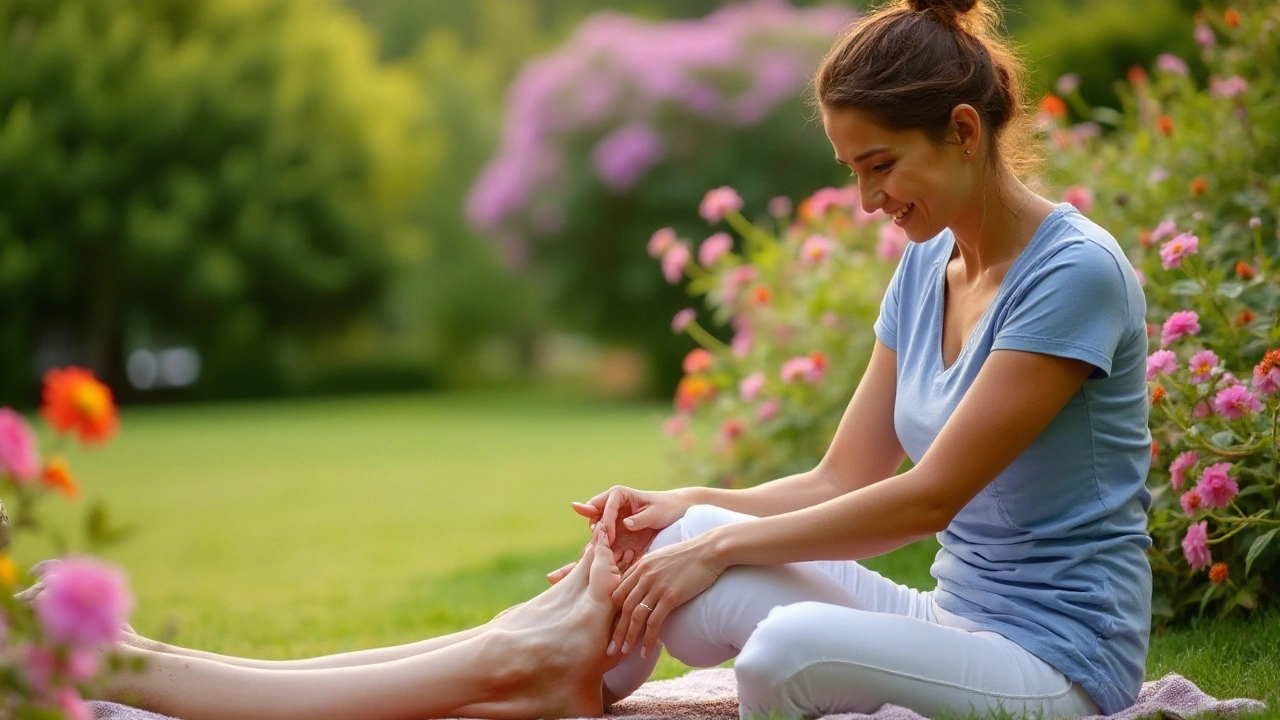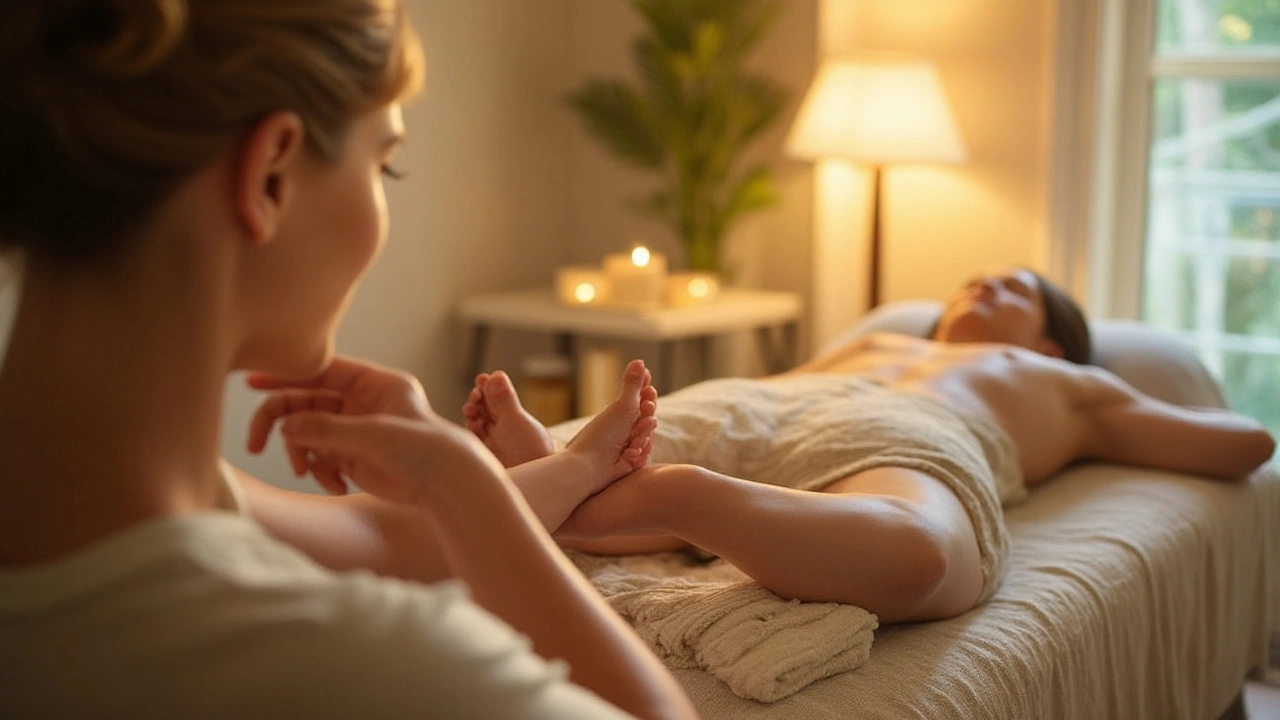In a world where modern medicine frequently takes center stage, there's a growing interest in alternative therapies that offer a different approach to healing and wellness. Reflexology stands out as a fascinating practice that promises to unlock the body's natural healing abilities through strategic touch.
This time-honored technique involves applying pressure to specific points on the feet, hands, and ears. Each of these spots corresponds to different organs and systems in the body, and the theory is that manipulating these zones can relieve pain and support overall health.
So, what sets reflexology apart, and how can it be seamlessly woven into a daily wellness routine? Let's delve into its intriguing origins, understand its mechanisms, and explore the potential benefits that make it a noteworthy option in pain management.
- Origins of Reflexology
- How Reflexology Works
- Benefits and Techniques
- Incorporating Reflexology in Daily Life
Origins of Reflexology
Reflexology, as a therapeutic practice, harbors a rich history that spans back several millennia, with its earliest roots found in ancient civilizations. The journey begins more than 5,000 years ago in China and Egypt, where pictorial evidence suggests that pressure therapy was employed to treat ailments and enhance well-being. In the tomb of an Egyptian physician, Ankmahor, detailed wall carvings depict scenes of foot and hand treatment, indicating that the concept of healing through touch was valued amongst the Egyptians. These historical clues underline the enduring human pursuit to harness natural methods for health, predating many modern medical solutions.
In the East, Chinese medicinal practices also showcased early forms of reflexology. The ancient Chinese believed that vital energy, known as 'Qi,' flowed through pathways in the body called meridians. By applying pressure to specific points on the feet, it was thought that one could unblock these pathways and restore balance and health to the body. This holistic approach to health laid a foundation that would influence not just reflexology but also acupuncture and other traditional Chinese medicine practices. It's fascinating to note how these ancient philosophies echo into contemporary reflexology, yet remain distinct for their simplicity and accessibility.
"Health is a state of complete harmony of the body, mind, and spirit. When one is free from physical disabilities and mental distractions, the gates of the soul open." - B.K.S. Iyengar
Fast forwarding to the early 20th century, reflexology began to take shape in its modern form thanks to the pioneering work of European and American practitioners. A significant figure during this time was Dr. William H. Fitzgerald, an American ear, nose, and throat specialist who brought forth the 'zone therapy' concept. His work laid down the idea of dividing the body into ten vertical zones, reflecting modern reflexology's foundation. Soon after, Eunice Ingham, a physiotherapist, adapted these ideas and discovered that the feet were especially responsive to touch as they mirrored the body's structure. Her teachings and written works were pivotal in establishing reflexology as a systematic healing art in the West, paving the way for its integration into alternative medicine.
The practice has evolved with time, integrating scientific insights with age-old wisdom. Acknowledging its diverse origins highlights not just the historical but also cultural significance of reflexology. It draws on the collective experiences and insights of various cultures that, despite being worlds apart, shared a common belief in the power of healing touch. In today’s world, this practice stands as a testament to the enduring quest for natural methods to alleviate pain and encourage wellness, resonating with those in search of gently empowering therapies.

How Reflexology Works
The human body is an intricate tapestry of interconnected networks and systems. In the realm of reflexology, these connections are mapped onto specific points on the feet and hands, often referred to as reflex zones. Each zone is believed to correspond to a particular organ or system within the body. By applying precise pressure to these zones, reflexologists aim to influence physiological changes and promote healing responses.
The foundational principle of reflexology is based on the concept that the body possesses reflex circuits that connect various parts to one another via the nervous system. When pressure is applied to a particular area, it sends a signal through the nervous system, which can potentially trigger the appropriate response to alleviate discomfort or balance energy. This mechanism is akin to a domino effect, where stimulation in one part of the body influences another part. This approach to healing is not a revolutionary discovery; rather, it draws upon ancient practices, with evidence of similar methodologies found in Chinese and Egyptian cultures dating as far back as 2330 BCE.
"Reflexology is more than just a foot massage; it’s a natural healing modalitiy that focuses on stimulating the body’s own ability to heal itself," says Dr. Jane Buckle, a noted expert in complementary therapies. "It taps into the power of touch and the human body's innate wisdom."
One of the intriguing aspects of reflexology is its simplicity. Unlike some alternative treatments, it does not require complex equipment or invasive techniques. Practitioners use only their hands to apply pressure, relying on their trained awareness to discern which areas of the feet or hands need attention. Reflexologists often emphasize the texture and temperature of the skin, which can provide valuable insights into what may be happening internally. For instance, a cold foot might indicate poor circulation, while a tender spot could suggest underlying tension or stiffness.
Scientific inquiry into reflexology continues to gain traction. A study published in a recent journal found that individuals who received regular reflexology treatments reported decreased symptoms of chronic pain and enhanced mood states. Although modern science is only beginning to explore the intricacies of this therapeutic technique, anecdotal evidence and small-scale studies suggest potential pathways for its effectiveness. By fostering proper communication between various parts of the body, reflexology may support physical health and emotional well-being, making it a valuable asset in the holistic management of pain.
Reflexology is generally a safe practice. However, as with any health-related intervention, individuals should exercise caution, particularly if they have underlying health conditions or are pregnant. Consulting with healthcare professionals before embarking on a reflexology journey ensures that this complementary therapy complements other forms of treatment being undertaken. Ultimately, reflexology's capacity to harmoniously integrate with modern medicine while preserving its rich traditional roots represents a compelling fusion of ancient wisdom and contemporary knowledge. This is why it’s gaining popularity as a pain management tool around the world.

Benefits and Techniques
Reflexology is not just about making your feet feel pampered; it's much deeper than that. By applying pressure to specific areas, primarily on the feet, one can tap into a network of energy pathways that crisscross the human body. These pathways are believed to improve our well-being profoundly. The practice can be particularly beneficial in managing pain, which is why it's becoming a part of many people's wellness routines. The analgesic effects come from reduced stress, enhanced circulation, and balanced energy. These benefits aren't limited to physical pain alone but extend to emotional and mental health. Notably, reflexology helps improve sleep, boost mood, and generate a sense of calm amid life's chaos. No wonder it's gaining traction as a supportive pain management tool.
The specific techniques of reflexology are just as intriguing as the benefits they produce. Starting with a gentle warm-up, practitioners gradually focus on particular zones of the foot that correspond to different parts of the body. For instance, the toes represent the head and neck area, while pressure on the heel targets the lower back and intestines. The thumb-walking technique, often used in sessions, involves the application of firm pressure along the foot's zones in a creeping motion. This method helps identify and address tension points that might otherwise go unnoticed. In contrast, the pivot technique involves pressing and rotating in a circular motion to stimulate nerves linked to organs.
"Reflexology can significantly complement regular medical care, especially when its benefits are well-understood," explains Dr. Barbara Kunz, a respected author and expert in the field of reflexology.
While the thumb-walking and pivot techniques are common, reflexologists may customize sessions based on the individual's specific needs, aiming to cater to unique pain points and health issues. The beauty of reflexology is that it's not a one-size-fits-all approach. Practitioners often use pressure varying from light to intense, depending on what relieves discomfort for the person being treated. Some might prefer deep pressure for effective pain relief, while others opt for a lighter touch, giving the sense of gentle rhythm.
To highlight the adaptability of reflexology, here's an example of a simple session plan practiced at home:
- Begin with a warm foot soak, possibly enriched with magnesium salts, known for their relaxing properties.
- Spend a few minutes massaging the entire foot with both hands to relax the muscles.
- Use the thumb-walking technique to apply pressure from the heel to the toes, remembering to concentrate on any tender regions.
- End the session with gentle stroking from the ankle outward to help drain away tension.
Reflexology's versatility might be more enriching than initially assumed. Not only does it address physical ailments, but it also complements other treatments beautifully, serving as a holistic approach to achieving tranquility and relief. It's important to keep in mind that although reflexology offers numerous advantages, it should always be used as a complementary practice alongside conventional healthcare, not a replacement.

Incorporating Reflexology in Daily Life
Reflexology isn't just a therapy reserved for spa days or professional appointments; it's a practice that can be effectively woven into everyday routines. You don't have to be a seasoned practitioner to begin exploring its benefits in the comfort of your own home. Understanding a few basic techniques and dedicating a small slice of time can transform daily reflexology into a sustainable habit. Starting your day with a brief session can be incredibly revitalizing and set a positive tone. Scientific research reveals that morning practices often lead to consistent routines, mainly due to the quiet and focus of the start of the day. Regular application can lead to noticeable improvements in both physical and mental well-being, making it a worthy investment for anyone seeking holistic health.
One way to ease reflexology into your life is by creating a personal routine. Begin by setting aside ten minutes each day, forming a consistent practice that won't feel burdensome amidst a busy schedule. You might begin with a focus on foot massage, as it's not only effective but surprisingly relaxing. Start by sitting comfortably, using gentle movements to warm up your feet. Pay particular attention to your toes and heel, areas often loaded with tension. To target specific pain management concerns, refer to reflexology maps available in books or online resources, which highlight various pressure points. Consistency cultivates comfort and skill, so keep at it even if progress feels slow initially.
If you're keen on incorporating reflexology in a social aspect, consider sharing sessions with friends or family. Set up a soothing environment with calming music and dim lighting, turning the experience into a bonding activity. As reflexology can be easily taught and practiced, it can serve as a communal wellness venture. This exchange not only spreads knowledge but reinforces personal techniques through practice. According to wellness advocate Tara J. Collins, "Integrating wellness practices like reflexology within community settings not only strengthens relationships but also amplifies well-being outcomes through shared energy and intention."
For those who desire a more hands-off approach, investing in tools or devices can be beneficial. Foot rollers and reflexology mats offer an easy, effective way to stimulate reflex points during other activities. Imagine gently massaging your feet on a textured mat while unwinding with a book or watching TV. For tech-savvy individuals, smartphone apps provide guides and timers, ensuring each session is performed with mindful precision. Resources frequently include detailed models of the feet, hands, and ears, allowing users to tailor each session for targeted pain management.
Even within hectic schedules, reflexology can find its place and offer moments of serenity and healing. Whether practiced alone or with others, it invites an opportunity to reconnect with one’s body and enjoy a mini sanctuary from life's pressures. The beauty of reflexology lies in its flexibility; it doesn’t demand much more than commitment and gentle touch. Once incorporated, many find it an indispensable part of daily wellness and self-care.

